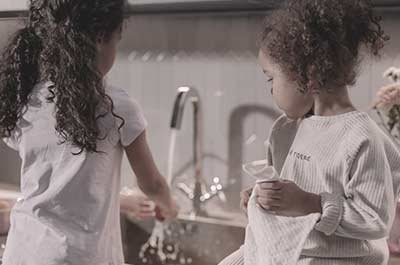Drawing upon our rich tapestry of experiences, we’ve woven together a guide that seeks to foster serene and joyous connections between your little ones and their furry companions.
Our adventures, both delightful and challenging, have germinated into a collection of insights and tips that have not only benefited our interactions but also have the potential to harmoniously unite children and pets in a beautiful dance of friendship and understanding.
Teach your kids how to read animals’ body language.
One of the most important things you can do is teach your kids how to read an animal’s body language. This will help them know when an animal feels scared, threatened, or even just wants to be left alone.
Some signs that an animal is feeling nervous or threatened include:
- Ears that are flattened back against the head
- A tail that is tucked between the legs
- Baring teeth
- Growling or hissing
If your child sees any of these signs, they should know to give the animal some space and not approach it. Dogs, in particular, communicate a lot through their body language. So, If you have a dog, take some time to teach your kids about the different ways dogs communicate. For example, a wagging tail doesn’t always mean a dog is happy – it can also be a sign that the dog is feeling scared or threatened.
Encourage your kids to be gentle with animals.
Most kids love animals, and it can be a great bonding experience for parents and children to spend time together caring for pets. However, it’s critical to make sure that kids treat animals kindly and with respect.
Your kids must know how to be gentle with animals. This means not pulling on their tails or ears, not hitting them, and not being too rough when playing with them. Dogs and cats, in particular, can get very stressed out if they are treated roughly. If your kids are gentle with animals, it will help the animals stay calm and be less likely to bite or scratch.
- Explain why it’s important to be gentle. Animals can get hurt if they’re treated roughly, just like people can. Help your child understand that it’s important to be careful with animals to keep them safe.
- Model gentle behavior yourself. If you want your child to be gentle with animals, it’s important to set an example yourself. Show them how to pet an animal calmly and confidently. Instead of playing tug-of-war with the dog, play fetch or have a gentle game of catch rather. Let the children see you being calm around all types of animals will teach them how they should behave as well.
- Encourage positive reinforcement. When your child is being gentle with an animal, praise them and let them know that they’re doing a good job. This will help reinforce positive behavior and
- Show your child how to pick up smaller animals gently, using both hands to support their weight.
By teaching your child to be gentle with animals, you can help them develop empathy and respect for all living creatures.
Make sure your kids know not to approach strange animals.
It’s important to teach your kids not to approach animals that they don’t know. Even if an animal looks friendly, it’s always best to err on the side of caution. Animals can be unpredictable, and even the most social dog or cat can bite or scratch if they’re feeling scared or threatened.
If you’re out in public, make sure your child knows not to approach any animals they don’t know, no matter how cute they may be. Explain that some animals may not want to be petted, and they should always ask the owner before trying to touch an animal.
Teach your kids not to approach pets when they’re eating, caring for their young, or sleeping.

Keep in mind that pets should never be disturbed when they’re eating or caring for their young. This can be a safety hazard, as even the most peaceful animal may lash out if they feel threatened.
So please, whatever you do, don’t let your kids approach pets in that situation! It’s just not worth the risk. Pets can be anxious and defensive when they’re eating or caring for their young, so it’s best to just leave them alone during these times.
Also, teach your kids not to bother animals when they’re sleeping. Animals need their rest and should be left alone when they’re trying to sleep. Just like people, animals need some time to themselves. It’s important to teach your kids to give animals the space they need, especially when they’re eating or sleeping.
Never leave a child alone with a pet.

Many people love animals and enjoy having them as pets, but it’s important to remember that they are still wild creatures.
They may be cute and cuddly, but they can also be dangerous, and it’s important to take precautions when around them, especially if there are small children present. Never leave a child alone with a pet, even for a moment.
Pets can be unpredictable, and a child may not know how to react if the animal becomes agitated or aggressive. In addition, small children are often not aware of the proper way to treat animals, and they may unintentionally hurt or annoy the pet.
For these reasons, it’s always best to supervise when children and pets are together.
If you must leave the room, put the pet in a safe place, such as a crate or enclosure, and make sure someone responsible is watching the child.
Make sure your pets are up-to-date on all their shots.
Another important safety measure is ensuring that your pets are up-to-date on all their shots. This will help protect them (and your kids) from diseases and illnesses. It’s also important to have your pets spayed or neutered. This will help reduce aggression and make them less likely to bite or scratch.
Here are a few tips to help you keep your pet’s shots up-to-date:
- Check with your veterinarian to see what shots are recommended for your pet.
- Make sure you keep track of when your pet’s shots are due. A good way to do this is to create a calendar or spreadsheet that includes all of the pertinent information.
- If you’re ever unsure whether or not your pet has received a particular shot, don’t hesitate to ask your veterinarian. They will be able to look up the records and let you know for sure.
Keep your pet’s nails trimmed.
Another important safety measure is to keep your pet’s nails trimmed. This will help prevent them from accidentally scratching or injuring your child. You can cut your pet’s nails yourself or take them to a professional groomer. Either way, it’s important to keep those nails short!
Here are a few tips for keeping your pet’s nails trimmed:
- Use a nail clipper designed specifically for pets.
- Be careful not to cut too close to the quick (the pink part of the nail). Cutting the quick can be painful for your pet and may cause bleeding.
- If you’re unsure about trimming your pet’s nails, ask your veterinarian or a professional groomer for help.
Instruct them on what to do if they see an animal that looks injured or sick.
If your child ever comes across an animal that looks injured or sick, they should not approach it. Instead, they should find an adult and let them know what they’ve seen. The adult can then decide whether or not to contact animal control or a wildlife rehabilitation center. Do not try to help the animal yourself, as you could be injured. Leave it up to the professionals to deal with sick or injured animals.
A sick animal might have diseases that could be passed on to humans, so it’s always best to err on the side of caution. Many animals also carry parasites that can be harmful to humans. If you must approach an injured or sick animal, make sure you’re wearing gloves and long sleeves to protect yourself.
Encourage your children to wash their hands after coming into contact with pets.

Children are notoriously messy, and they often put their hands in places they shouldn’t. That’s why it’s so important to encourage them to wash their hands after coming into contact with pets. This will help remove any dirt, bacteria, or parasites that might be on their hands. Ensure you have a designated place for them to wash their hands, such as the kitchen sink or a bathroom.
You should also wash your hands after coming into contact with pets. This is especially important if you’re preparing food or eating. Usually, soap and water are enough to clean your hands. But if you’re worried about bacteria or parasites, you can also use hand sanitizer. Keeping your pet clean is also important for preventing the spread of disease.
Instruct your children on what to do if they are bitten or attacked by a pet.
No matter how well you supervise your children and how many safety measures you take, accidents can still happen. That’s why it’s so important to instruct your children on what to do if they are bitten or attacked by a pet.
If a pet ever attacks your child, the first thing they should do is try to get away. If they can’t get away, they should try to fight back and protect themselves as best they can. Once they’re safe, the next thing they should do is seek medical attention. Even if the bite or attack doesn’t seem serious, it’s always better to err on the side of caution and have your child checked out by a doctor.
You can help them by role-playing different scenarios so they know how to react if it ever happens. For example, you can pretend to be a dog and have your child practice getting away and fighting back.
Conclusion.
Pets can provide so much love and companionship for children, but it’s important to remember that they are still animals with sharp teeth and claws. By following these simple tips, you can help your child stay safe around pets and enjoy all the benefits they offer. Do you have any other safety tips to share?

Dive into the insights of Matthew Mansour, a seasoned life coach, fitness guru, and health mentor. With a portfolio boasting over 800 thought-provoking articles, Matthew is passionate about unraveling the intricate layers of the human psyche. His reading choices? Books that shed light on our unique human journey, helping him (and his readers) harness the power of the mind, transforming challenges into stepping stones.
Matthew proudly wears his badge as a self-help aficionado. His mantra? There’s always room to grow, learn, and be inspired. He thrives on gleaning wisdom from pioneers, turning their experiences into valuable lessons for all.
Always on the pulse of emerging trends, Matthew immerses himself in groundbreaking courses and research centered around life coaching and holistic health. Eager to impart his knowledge, he’s here to guide anyone keen on enhancing their life journey.
Beyond his professional persona, Matthew is a devoted animal lover, a proud New Jersey resident, and a doting husband and father. Dive into his self-improvement blog and let Matthew guide you towards a life filled with purpose and passion!
Reviewed By: Joanna Perez and Marcella Raskin
Edited By: Lenny Terra
Fact Checked By: Gabrielle J. Smith
Photos Taken or Curated By: Matthew Mansour